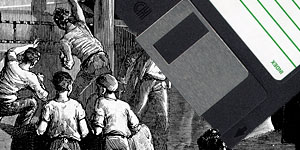


Machines That Own the World
Over the last few decades, we have all watched computers evolve before our eyes. Astoundingly, over the past fifty years computing got about seventy million times cheaper. Today, computing costs halve roughly every eighteen months. If travel costs dropped that fast, we could fly to the moon for about a dollar.That astounding pace of improvement, coupled with the ability to follow any well-defined sequence of actions, has let computers do and be things we used to believe only we could do and be. As a result, they have rapidly changed both our jobs and our way of life. Between 1950 and 1980, for example, the number of long-distance calls made in the United States increased fifteenfold, while the number of telephone operators halved. AT&T is currently replacing a third of its long-distance operators---over six thousand people---with voice-recognition computers. The remaining two-thirds may not survive the next decade of technological advance.
Fully functional computers have already shrunk from warehouse size to wallet size. They've stopped there for the moment only because we couldn't type on them if they were any smaller. One day, though, they'll see and hear and speak in limited ways, as well as display images for us---perhaps on the lens of a pair of sunglasses. Then, since we won't have to type on them anymore, they'll shrink even further. Eventually, they'll set up shop on our clothes, in our hair, and inside our bodies.
Computers are already as common as dishwashers, although they're not as easy to use. But, then, they do far more. Millions of them are running in watches, cars, and microwave ovens; powering satellites, jetliners, and cruise missiles; and working in hospitals, armies, and governments. They're busy changing our lives.
In the computer world, costs halve and complexity doubles roughly every eighteen months and have done so for well over thirty years. How can anyone cope when basic engineering premises change every three years? Common sayings in the computer industry are "Stress for success" and "If you don't come in on Saturday, don't bother showing up on Sunday." Hundred-hour weeks aren't unheard of. The pace is so incredible that looking two years ahead is considered a long-range plan. Five years ahead is the distant future. And, because computers help us design and build better computers, the self-improvement ball might well keep rolling for a long time to come.
Take the development of batteries and flat computer screens, for example. Once they passed a certain performance threshold, portable computers became economic. When portables started appearing, demand for them grew. That higher demand pushed battery and screen development into high gear to capture more of the market. Improved batteries then rushed into video cameras, copiers, and scanners, while improved screens stampeded into light meters, television sets, and microwave ovens. Sales of these products exploded the market for batteries and screens, which (again) forced the industry to develop even better batteries and screens, which led to better portables, which led...
The industry's favorite words seem to be double and halve: Either performance doubles or prices halve every year or so. Every year, size, energy needs, waste heat, and costs drop, while speed, power, reliability, yields, sales, expertise, and complexity rise. It's hard to grasp what such a rate of change can do because we're not used to it in everyday life. We're used to things that increase slowly. But exponential growth is something special. Folding a piece of paper in half halves its area and doubles its thickness; its thickness rises exponentially with the number of foldings. Folding it just ten times makes it thicker than a thousand-page book. If we could fold a piece of paper just twenty-three times, it would be taller than a ten-story building. Fold it just once more and it becomes taller than a twenty-story building. Exponentials grow fast.
As computer expertise, profit, and uses rise, demand rises. As demand rises, research and investment rise. As research and investment rise, expertise, profit, and uses rise. Each company has to ride each wave of the vicious cycle just to have enough money and expertise to start the next cycle, always trying to keep one step ahead of the competition, always spiraling ever further down the quantum rabbit hole. In this ecosystem, innovation follows innovation and competition is more cutthroat than in any jungle. Rest on last year's laurels and you're next year's fishbait.
Of course, that can't go on forever---only as long as the market is growing and computer technology is improving. Possibly, though, it won't slow down until everything comes alive, until we have a world where we can talk to every inanimate object and get an answer back. In that world, everything can be smart: not just toasters and pencils, cars and televisions, but also cows and books, corn and doors, medical implants and shoes.
We appear headed toward a world where the phrase "to hear is to obey" takes on a whole new meaning. It may be a world of smart houses that talk to sentient sunglasses, a world of sprites and genies and things that go bump in the night as they go about their business, a world where walls have ears, and pigs can sing. A strange new world.